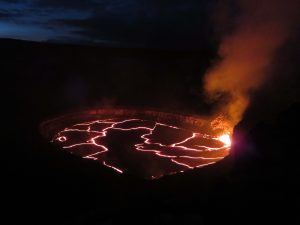VOLCANO WATCH: Kīlauea’s Gravity Changes

A wide view looking northeast, of the lake in Halemaʻumaʻu Crater as seen late Monday, June 27, 2016. Jaggar Museum and HVO are beyond the left edge of the photograph. Spattering was active in the southeast portion of the lake. The lava lake dropped more than 15 m (49 feet) between the time the photo was taken and mid-day Thursday, June 30, 2016. USGS photo.
Readers of “Volcano Watch” might recall past articles that have described various ways in which the USGS Hawaiian Volcano Observatory studies and monitors the active volcanoes of Hawai‘i.
Today, we focus special attention on just one of those techniques: gravity.
We tend to think of gravity as a constant—a force that pulls on everyone equally, everywhere. But this is not quite true. In fact, the force of gravity depends on the mass beneath your feet, and your distance from that mass.
If there is something very dense beneath the ground, like a solidified magma chamber, gravity is a bit stronger in that area.
Conversely, the farther you are from the Earth’s center, the weaker gravity is. For example, you weigh slightly less (by a small fraction of a pound) at the 4169-m (13,678-foot) summit of Mauna Loa than at sea level in Hilo!
Gravity can also change over time. As magma accumulates beneath the ground, it pushes the ground upward, causing gravity to decrease. This change is counterbalanced, however, by the new mass of magma beneath the ground, which causes gravity to increase.
By measuring gravity and surface deformation at the same time, these effects can be separated. This makes it possible to use gravity to measure just how much magma may be moving beneath the ground.
Measurements of gravity change have been conducted at Kīlauea since the 1970s, usually by surveying a network of points conducted every year or so. A noteworthy result of these studies is the recognition that there are void spaces—probably a network of interconnected cracks rather than a single large cavern—beneath the volcano’s surface. Magma accumulation in these voids causes a gravity increase due to the addition of mass, but there is little associated surface uplift.
In the past several years, gravity changes have also been measured by continuously recording instruments installed at three locations on Kīlauea. These measurements allow volcanologists to detect rapid changes in mass beneath the surface that might otherwise go undetected. They have also revealed surprising insights about Kīlauea’s summit lava lake.
Island residents might remember the eventful volcanic activity at Kīlauea in 2011. In March that year, the summit lava lake within Halema‘uma‘u Crater drained due to the onset of the Kaomamoa fissure eruption near Puʻu ʻŌʻō on the volcano’s East Rift Zone. The dropping lava lake level was associated with a major decrease in gravity measured by an instrument on the rim of Halemaʻumaʻu.
A nearby thermal camera also tracked the lowering lava lake level, making it possible to calculate the volume of lava that drained from the lake. Knowing the mass and volume, we can determine an important physical property of lava: density.
The density of the basaltic rocks that make up most of the Island of Hawaiʻi is about 2.5 times the density of water. HVO scientists expected Kīlauea’s summit lava lake to be slightly less dense than the rock, given the gases contained in the lava, but not by much.
The gravity and thermal camera data from the draining of the lava lake in March 2011, however, revealed that the upper 200 m (650 feet) or so of the lake has a density less than that of water! Apparently, the upper part of the lava lake is frothier than expected due to the large amount of gas in the lava.
The Kīlauea summit vent gravity station has recorded changes over several years since 2011, through many cycles of lava lake level rise and fall. These data clearly demonstrate that the lava lake density has remained low, roughly equal to that of water.
Abrupt changes in gravity have also occurred a few times since 2011, signaling the arrival of fresh batches of magma near the summit. These gravity data, therefore, provide important information, not just about lava lake characteristics, but also about subsurface magma movement that might otherwise be overlooked.
Kīlauea is a wonderful “natural laboratory” in which we can develop advanced methods of volcano monitoring and research, like continuous gravity. In the years to come, HVO looks forward to refining our techniques for measuring gravity change and sharing them with scientists who are studying other US volcanoes, such as Mount St. Helens.
Volcano Activity Updates
Kīlauea continues to erupt at its summit and East Rift Zone. During the past week, the summit lava lake level varied between about 25 m and 41 m (82–133 feet) below the vent rim within Halema‘uma‘u Crater.
On the East Rift Zone, the June 27th lava flow is inactive.
The eastern Pu‘u ‘Ō‘ō breakout remained active, producing a lava flow (informally called the “61g flow”) that continued to advance to the southeast. As of June 29, 2016, the flow was about 7.3 km (4.5 mi) long. No lava flows were threatening nearby communities.
Mauna Loa is not erupting. Seismicity rates have decreased since the earthquake activity recorded in late May, but remain above background levels. Deformation related to inflation of a magma reservoir beneath the summit and upper Southwest Rift Zone continues, with inflation recently occurring mainly in the southwestern part of Mauna Loa’s magma storage complex.
No earthquakes were reported felt on the Island of Hawaiʻi this past week.
Volcano Watch is a weekly article and activity update written by U.S. Geological Survey Hawaiian Volcano Observatory scientists and affiliates.
Call for summary updates at (808) 967-8862 (Kīlauea) or (808) 967-8866 (Mauna Loa); email questions to [email protected].













